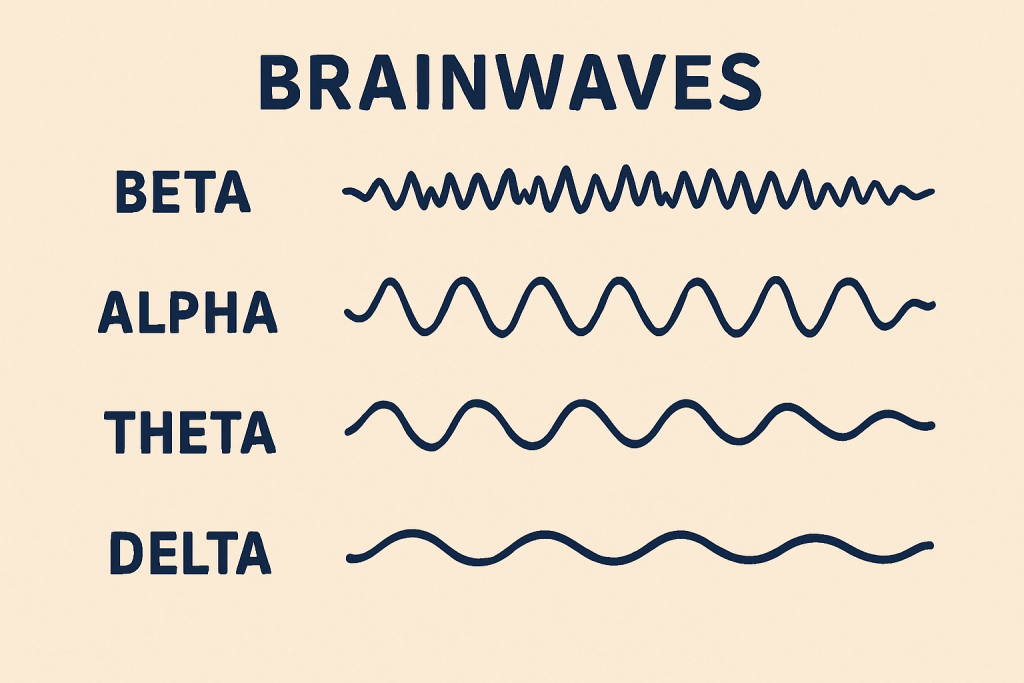Sleep shouldn’t feel like a nightly battle. But for many people, it is.
You go to bed exhausted, but your mind won’t cooperate. Thoughts race, your body feels restless, and before you know it, it’s 2 am and you’re still wide awake.
Sound familiar?
You’re not alone. At the Inspired Performance Institute, we’ve worked with many individuals who have difficulty falling asleep. In fact, sleep issues are one of the common signs that your nervous system hasn’t fully come out of a high-alert state.
The good news is you don’t have to stay sleep-deprived. You can train your brain to fall asleep faster and easier. And you don’t need sleeping pills or complicated sleep hacks to do it — just a deeper understanding of how your brain works.
Sleep isn’t just about closing your eyes. It’s a neurological process that depends on your brain transitioning through different wave states.

There are four main brainwave states:
The biggest mistake people make? Trying to go directly from beta to theta.
It’s too much of a jump. Here’s what to do instead.
To fall asleep easier and faster, you have to guide your brain gradually from beta to alpha, and then into theta. Here’s how to do that.
One of the biggest barriers to falling asleep is the pressure we put on ourselves to fall asleep. The more you try to force it, the more elusive it becomes.
So instead of saying, “I need to fall asleep now,” tell yourself, “I’m just going to rest.” Let go of the outcome. This simple shift reduces stress and tells your brain that it’s safe to relax.
One simple way to enter alpha is to read. Reading calms the mind and narrows your focus. But be mindful of light — bright lights can suppress melatonin, your body’s natural sleep hormone. Try reading under a dim, warm-toned light.
Breathing is one of the most effective tools to help your mind get ready for sleep. Deep, intentional breathing slows down the nervous system and creates a sense of safety in the body.
One method I teach my clients the simple 5-6-7 breathing method:
Repeat this cycle a few times. You’ll feel your body start to relax, and your mind will begin to slow.
Tactile stimulation is one of the most overlooked sleep tools, and it’s something you used to do naturally when you were a child.
Watch a child trying to fall asleep — they’ll start rubbing their blanket, touching their pillow, or even stroking a parent’s hair. This instinctive behavior calms the nervous system.
You can do the same to distract your mind and get it to slow down.
Use a soft pillow, blanket, or fabric that feels comforting. Gently rub your fingers together or feel the texture of your sheets. This subtle tactile input helps redirect your brain’s focus away from spiraling thoughts.
If your body feels tense or wired, try progressive muscle relaxation.
This technique works by alternating tension and release, helping your muscles and your nervous system let go of residual stress.
Start at your feet. Squeeze your toes tightly for 5 seconds. Then release.
Move up to your calves. Tense for 5 seconds. Release.
Then your thighs. Your stomach. Your hands. Your shoulders. Even your face.
Tense. Hold. Release.

This intentional sequence helps your body shift out of tension and into stillness, telling your body it’s time to shut down. It also builds the body awareness needed to stay grounded and calm.
Even if you’re doing all the right things to slow your brain down, light exposure can sabotage your sleep.
Your brain uses light to determine when to release melatonin. If you’re exposed to blue light from screens or bright bulbs in the evening, your brain thinks it’s still daytime. Blue light disrupts melatonin production, the hormone your brain releases to trigger sleep.
That includes phones, TVs, tablets, and even bright reading lights.
Avoid screens an hour before bed if possible. If you’re reading, use a dim, warm-toned light. If you’re used to falling asleep watching TV, get your TV or device on a timer so it doesn’t stay on and overstimulate your brain.
When the room is dark and your mind is calm, your brain knows it’s safe to slip into sleep.
Figuring out sleep can feel like solving a Rubik’s cube. There are many combinations and it’s about finding the one that fits you.
For some, it’s a warm shower and reading. For others, it’s a longer nighttime routine and breathing. And, for some, it’s just about stopping using your phone, computer and TV an hour before you go to bed.
The important part is consistency. When your brain learns a predictable pattern, it knows when to start winding down.
If you’re struggling with sleep and nothing seems to work, there may be deeper patterns at play. At the Inspired Performance Institute, we’ve helped thousands of clients overcome anxiety, burnout, and chronic sleep issues by rewiring how the brain processes stress.
Our TIPP Program is designed to help you restore calm at the root level.
Would you like to learn more? Book a call with a TIPP advisor to find out how we can help you sleep better, think clearer, and live fully.